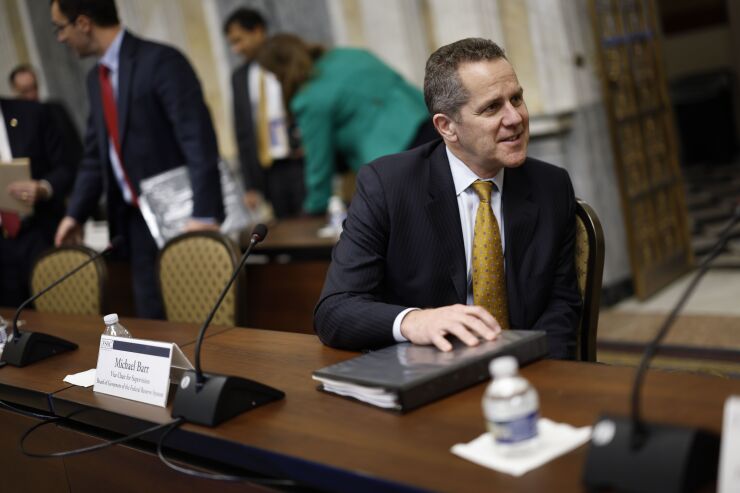
Federal Reserve Vice Chair for Supervision Michael Barr said Friday federal bank supervisory teams have ramped up inspection of the banks they supervise given a "heightened risk environment" drawing on lessons from
"The Federal Reserve has issued more supervisory findings and downgraded firms' supervisory ratings at a higher rate in the past year [and] increased our issuance of enforcement actions," he said. "These actions do not represent a change in policy; they reflect the impact of the changing economic, interest rate, and financial environment on a bank's financial resources."
In the remarks — delivered to a crowd at Columbia Law School's annual banking conference — Barr discussed how supervisors can address emerging 'gray areas' of risk that aren't yet formally subject to regulations. Specifically, Barr touched on how the Fed has translated lessons learned from the failure of Silicon Valley Bank, as detailed in a post-mortem report
Many policymakers, including Barr, have highlighted the significance of the Economic Growth, Regulatory Relief, and Consumer Protection Act of 2018, also known as S. 2155, in removing the automatic enhanced regulatory requirements that SVB would have previously encountered as the bank expanded in size.
While the removal of the automatic regulatory trigger could have potentially influenced SVB's risk trajectory, Barr emphasized in his remarks that risks don't spontaneously manifest at banks with this level of assets. He said much of the risk at SVB had accumulated prior to the bank crossing the $100 billion threshold. Therefore, he said, Fed supervisors will continue to apply additional scrutiny to large regionals nearing $100 billion in assets, while smaller firms shouldn't anticipate any supervisory changes.
"For large and more complex regional banking organizations, including firms that are growing rapidly, we are assessing such a firm's condition, strategy, and risk management more frequently, and deepening our supervisory interactions with the firm," he said.
Barr said Fed supervisors are also actively pushing firms nearing the threshold to proactively invest in scaling their capabilities to ensure a more seamless regulatory transition. To accomplish this, he said, the agency is ensuring supervisory teams overseeing such banks maintain communication with those overseeing banks already above the threshold.
"Application of standards for larger banks should not require significant changes in a firm's risk management capabilities because the bank should have been making these investments along the way," he said. "The goal is that the transition to heightened supervision for fast-growing banks is more of a gradual slope and not a cliff."
Barr also noted supervisors are stepping up their scrutiny of any high volumes of unrealized losses at financial institutions — another major driver of SVB's collapse.
"Examiners have been conducting additional targeted examinations for firms with large unrealized losses or other vulnerabilities," he said. "For a small number of banks with a risk profile that could result in funding pressures for the firm, supervisors are continuously monitoring these firms."
Barr also discussed regulators' ongoing work to assess public comments on their proposed hike in the capital requirements — dubbed
Barr said the agency is assessing the public comments on both the rule itself and a
"We're analyzing the comment letters, we take the comment process really seriously," he said. "We want to make sure we get the capital rule right [and] if we need to make adjustments to it, we'll make adjustments to it. We're in the process of thinking through what those adjustments might be."
Barr also addressed ongoing uncertainty about banks' exposure to cratering values in certain commercial real estate across the country. While Barr noted regulators are watching this issue carefully, he assured the crowd that there is significant variety in the quality of CRE depending on geography and property type.
"We don't look at it as a monolith," he said. "There's a lot of heterogeneity in the market. So there's some markets — some cities — that are doing really, really well and some cities where there's more vulnerability, and even within a city you can have the A Class buildings doing just fine and the B and C class buildings not so fine."
Another risk he's monitoring is the potential for artificial intelligence to cut humans out of banking activities — also known as automaticity — which he says is a recipe for risk. The risk is particularly salient when firms use a narrow range of AI models which could potentially cause firms to take actions in parallel — sometimes called herd behavior — as regulators have
"If all of us are using the same AI system or a very narrow number of systems, you have ubiquity," he said. "You put together ubiquity, automaticity and speed, you can get serious risks, and so we were trying to think very long term about those kinds of issues."






